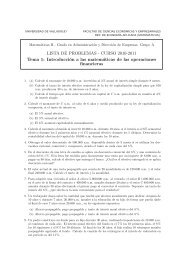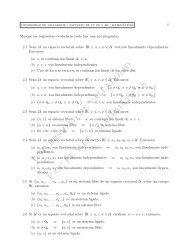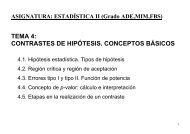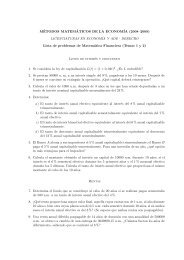A DISTANCE-BASED EXTENSION OF THE MAJORITY ...
A DISTANCE-BASED EXTENSION OF THE MAJORITY ...
A DISTANCE-BASED EXTENSION OF THE MAJORITY ...
Create successful ePaper yourself
Turn your PDF publications into a flip-book with our unique Google optimized e-Paper software.
6 EDURNE FALCÓ AND JOSÉ LUIS GARCÍA-LAPRESTA<br />
us to avoid some of the problems associated with MJ and RV. See García-Lapresta<br />
and Martínez-Panero [7] for a different proposal based on centered OWA operators<br />
(Yager [10]).<br />
3.3. Tie-breaking method. Usually there exist more alternatives than linguistic<br />
terms, so it is very common to find several alternatives sharing the same collective<br />
assessment. But irrespectively of the number of alternatives, it is clear that<br />
some of them may share the same collective assessment, even when the individual<br />
assessments are very different. For these reasons it is necessary to introduce<br />
a tie-breaking method that takes into account not only the number of individual<br />
assessments above or below the obtained collective assessment (as in MJ), but the<br />
positions of these individual assessments in the ordered scale associated with L. As<br />
mentioned above, we will calculate the difference between two distances: one between<br />
l(x j ) and the assessments higher than l(x j ) and another one between l(x j )<br />
and the assessments lower than the l(x j ). Let v + j and v − j the vectors composed<br />
by the assessments vj<br />
i from ( vj 1, . . . , ) vm j higher and lower than the term l(xj ),<br />
respectively. First we calculate the two following distances:<br />
D + (x j ) = ¯d p<br />
(<br />
v<br />
+<br />
j , (l(x j), . . . , l(x j )) ) ,<br />
D − (x j ) = ¯d p<br />
(<br />
v<br />
−<br />
j , (l(x j), . . . , l(x j )) ) ,<br />
where the number of components of (l(x j ), . . . , l(x j )) is the same that in v + j and<br />
in v − j , respectively (obviously, the number of components of v + j and v − j can be<br />
different). Once these distances have been determined, a new index D(x j ) ∈ R<br />
is calculated for each alternative x j ∈ X: the difference between the two previous<br />
distances:<br />
D(x j ) = D + (x j ) − D − (x j ).<br />
By means of this index, we provide a kind of compensation between the individual<br />
assessments that are bigger and smaller than the collective assessment, taking into<br />
account the position of each assessment in the ordered scale associated with L.<br />
For introducing our tie-breaking process, we finally need the distance between the<br />
individual assessments and the collective one:<br />
E(x j ) = ¯d p<br />
(<br />
(v<br />
1<br />
j , . . . , v m j ), (l(x j ), . . . , l(x j )) ) .<br />
Notice that for each alternative x j ∈ X, E(x j ) minimizes the distance between<br />
the vector of individual assessments and the linguistic labels in L, such as has<br />
been considered above in the definition of L(x j ). The use of the index E(·) is<br />
important in the tie-breaking process because if two alternatives share the same<br />
couple (l(·), D(·)), the alternative with the lower E(·) is the alternative whose<br />
individual assessments are more concentrated around the collective assessment, i.e.,<br />
the consensus is higher. Summarizing, for ranking the alternatives we will consider<br />
the following triplet<br />
T (x j ) = (l(x j ), D(x j ), E(x j )) ∈ L × R × [0, ∞)<br />
for each alternative x j ∈ X. The sequential process works in the following way:<br />
(1) We rank the alternatives through the collective assessments l(·). The alternatives<br />
with higher collective assessments will be preferred to those with<br />
lower collective assessments.
















